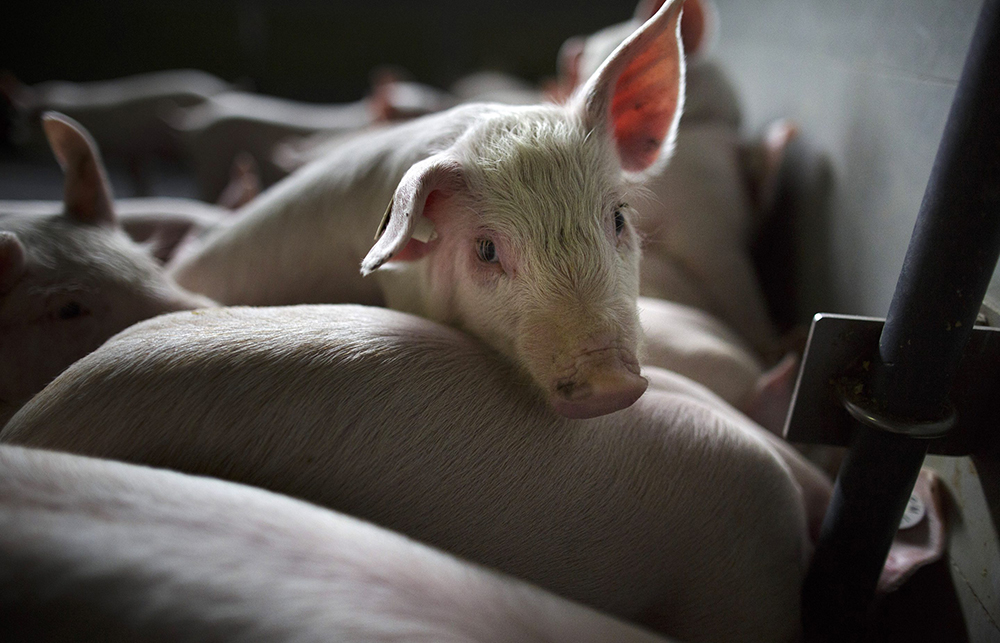
多年以來,如何控制甲烷排放一直是畜牧業所關注的一大問題,而隨著第26屆聯合國氣候變化大會(COP26)的逐步推進,相關討論也很自然地轉移到了這一問題上來。但當控制甲烷排放成為氣候問題的焦點時,我們必須確保在對話中發出正確的聲音,從而找到具有影響力的解決方案。
美國總統喬·拜登提出的“全球甲烷承諾”(Global Methane Pledge)是讓農場主參與到監管對話中的絕佳機會,截至目前,已經有100多個國家簽署了該承諾。農場主可以為相關問題的解決提供極富價值的意見和見解。借助他們的經驗和貢獻,我們將能夠在制訂緊急氣候解決方案的同時,繼續養活這個世界,在二者之間達到平衡。
只需要將牲畜的甲烷排放量減少三分之一,就可以減緩全球變暖的整體速度,產生降溫效應,同時讓世界獲得更多時間來應對更為復雜、影響更為長久的二氧化碳問題。如果沒有農場主、牧場主和土地所有者參與氣候變化相關對話,我們就將無法提出可行的解決方案。
在今年一項覆蓋1000多名受訪者的調查中,禮藍動保(Elanco)發現,每5名素食者中就有2人認為畜牧業是美國溫室氣體的最大來源,相信其溫室氣體排放量多過其他任何行業,但這種認識其實并不正確。
聯合國政府間氣候變化專門委員會(IPCC)指出,家畜產生的溫室氣體排放量僅占美國溫室氣體排放量的4%,而其他單一行業的排放量占比可達75%。許多人沒有意識到的是,畜牧業已經在減少自己的環境足跡。
根據聯合國糧食及農業組織(Food and Agriculture Organization of the United Nations)的數據,從1961年到2017年,生產牛肉、牛奶、雞肉、雞蛋和豬肉造成的溫室氣體全球平均排放強度分別下降了30%到60%。
畜牧業已經為迎接更大規模的持續性變革做好了準備,但我們必須得到科學的引導,相關法律法規的制訂也需要考慮到管理土地的農場主、牧場主和林場主的實際情況。因為養活世界和氣候降溫二者之間密切相關。
2020年,全球有超過30%的人口無法確保全年都能夠獲得充足的食物。根據美國農業部(U.S. Department of Agriculture)的數據,貧窮國家有9.21億人口的糧食缺乏保障,較新冠疫情爆發前增加了1.6億人。此前,工業化國家曾經承諾通過為新興經濟體提供財政支持、對援助和彈性措施進行投資來改變缺糧現狀,但他們卻未能達成自己的目標,這也是第26屆聯合國氣候變化大會召開期間的一個主要爭議點。
為避免對環境造成額外壓力,我們必須以可持續的方式來滿足(全球人口的)蛋白質需求。我們必須抓住機會,通過畜牧業創新在肉類生產中實現氣候中性,而不是以犧牲全球糧食安全為代價。
從業者可以做些什么
為共同應對氣候變化和全球饑餓問題,農場主、牧場主和土地所有者主要關注四大問題:
實施衡量系統,將可持續性納入日常運營與業務決策。
鼓勵創新,推動研發甲烷捕獲、轉化等新技術。
為農場主創造從可持續經營實踐中獲益的市場和機會。
與農場主、牧場主和土地所有者進行溝通,幫助他們了解氣候中立的可能性,使其明白行業協作是實現相關目標的必要條件。
我們必須傾聽土地管理者的聲音。滿足人類的營養需求、遏制氣候變化和實現經濟可持續發展都是迫在眉睫且相互關聯的全球性挑戰,動物能夠也必將成為相關解決方案的關鍵內容。現在正是真正落實“從農場到餐桌”的最佳時機,讓畜牧業專家可以把自己的專業知識帶到相關的全球對話之中,讓我們能夠成功合作,帶來變革。(財富中文網)
本文作者杰夫·西蒙斯是禮藍動保(Elanco Animal Health)的總裁兼首席執行官。禮藍動保是全球動物保護領域的領導者,該組織致力于提升動物、人類和地球的健康水平。
譯者:梁宇
審校:夏林
多年以來,如何控制甲烷排放一直是畜牧業所關注的一大問題,而隨著第26屆聯合國氣候變化大會(COP26)的逐步推進,相關討論也很自然地轉移到了這一問題上來。但當控制甲烷排放成為氣候問題的焦點時,我們必須確保在對話中發出正確的聲音,從而找到具有影響力的解決方案。
美國總統喬·拜登提出的“全球甲烷承諾”(Global Methane Pledge)是讓農場主參與到監管對話中的絕佳機會,截至目前,已經有100多個國家簽署了該承諾。農場主可以為相關問題的解決提供極富價值的意見和見解。借助他們的經驗和貢獻,我們將能夠在制訂緊急氣候解決方案的同時,繼續養活這個世界,在二者之間達到平衡。
只需要將牲畜的甲烷排放量減少三分之一,就可以減緩全球變暖的整體速度,產生降溫效應,同時讓世界獲得更多時間來應對更為復雜、影響更為長久的二氧化碳問題。如果沒有農場主、牧場主和土地所有者參與氣候變化相關對話,我們就將無法提出可行的解決方案。
在今年一項覆蓋1000多名受訪者的調查中,禮藍動保(Elanco)發現,每5名素食者中就有2人認為畜牧業是美國溫室氣體的最大來源,相信其溫室氣體排放量多過其他任何行業,但這種認識其實并不正確。
聯合國政府間氣候變化專門委員會(IPCC)指出,家畜產生的溫室氣體排放量僅占美國溫室氣體排放量的4%,而其他單一行業的排放量占比可達75%。許多人沒有意識到的是,畜牧業已經在減少自己的環境足跡。
根據聯合國糧食及農業組織(Food and Agriculture Organization of the United Nations)的數據,從1961年到2017年,生產牛肉、牛奶、雞肉、雞蛋和豬肉造成的溫室氣體全球平均排放強度分別下降了30%到60%。
畜牧業已經為迎接更大規模的持續性變革做好了準備,但我們必須得到科學的引導,相關法律法規的制訂也需要考慮到管理土地的農場主、牧場主和林場主的實際情況。因為養活世界和氣候降溫二者之間密切相關。
2020年,全球有超過30%的人口無法確保全年都能夠獲得充足的食物。根據美國農業部(U.S. Department of Agriculture)的數據,貧窮國家有9.21億人口的糧食缺乏保障,較新冠疫情爆發前增加了1.6億人。此前,工業化國家曾經承諾通過為新興經濟體提供財政支持、對援助和彈性措施進行投資來改變缺糧現狀,但他們卻未能達成自己的目標,這也是第26屆聯合國氣候變化大會召開期間的一個主要爭議點。
為避免對環境造成額外壓力,我們必須以可持續的方式來滿足(全球人口的)蛋白質需求。我們必須抓住機會,通過畜牧業創新在肉類生產中實現氣候中性,而不是以犧牲全球糧食安全為代價。
從業者可以做些什么
為共同應對氣候變化和全球饑餓問題,農場主、牧場主和土地所有者主要關注四大問題:
實施衡量系統,將可持續性納入日常運營與業務決策。
鼓勵創新,推動研發甲烷捕獲、轉化等新技術。
為農場主創造從可持續經營實踐中獲益的市場和機會。
與農場主、牧場主和土地所有者進行溝通,幫助他們了解氣候中立的可能性,使其明白行業協作是實現相關目標的必要條件。
我們必須傾聽土地管理者的聲音。滿足人類的營養需求、遏制氣候變化和實現經濟可持續發展都是迫在眉睫且相互關聯的全球性挑戰,動物能夠也必將成為相關解決方案的關鍵內容。現在正是真正落實“從農場到餐桌”的最佳時機,讓畜牧業專家可以把自己的專業知識帶到相關的全球對話之中,讓我們能夠成功合作,帶來變革。(財富中文網)
本文作者杰夫·西蒙斯是禮藍動保(Elanco Animal Health)的總裁兼首席執行官。禮藍動保是全球動物保護領域的領導者,該組織致力于提升動物、人類和地球的健康水平。
譯者:梁宇
審校:夏林
As the United Nations Climate Change Conference (COP26) unfolded, the conversation on climate rightfully shifted to where animal agriculture has been focused for years: combating methane. But as we put methane in the climate crosshairs, we must ensure we are bringing the right voices to the table to identify impactful solutions.
U. S. President Joe Biden’s Global Methane Pledge, now signed by more than 100 countries, is a perfect opportunity to include farmers in conversations about regulation. Farmers bring critical insight to the problem-solving process. Their experience and input will help us thread the needle to enact urgent climate solutions while continuing to feed the world.
Curbing livestock methane emissions by just a third can slow the overall rate of warming, creating a cooling effect while allowing the world more time to address the more complex and long-term CO2 impacts. Without farmers, ranchers, and landowners at the table in climate change conversations, we can’t bring forward feasible solutions.
This year, in a survey of over 1,000 participants, Elanco found that two out of five people who avoid consuming meat believe animal agriculture is the biggest creator of greenhouse gases (GHG) in the U.S., contributing more than any other industry—but that’s wrong.
The Intergovernmental Panel on Climate Change (IPCC) of the United Nations states that livestock generates 4% of U.S. GHG emissions, whereas other singular industries can represent up to 75%. What many don’t realize is that animal agriculture already has a track record of reducing its environmental footprint.
According to data from the Food and Agriculture Organization of the United Nations (FAO), the global average GHG emission intensities for beef, milk, chicken, eggs, and pork have all declined between 30% and 60% from 1961 to 2017.
The animal agriculture industry is poised to usher in continued and greater changes, but science must guide us, and we need regulations that consider the farmers, ranchers, and foresters who steward our land. Because feeding the world and cooling the climate are interconnected issues.
In 2020, more than 30% of the global population lacked year-round access to adequate food. And according to the U.S. Department of Agriculture (USDA), 921 million people in the world’s poorer countries are food insecure—an increase of 160 million since the COVID-19 pandemic began. Industrialized nations that previously committed to changing this through financial support of emerging economies and investment in aid and resiliency measures are missing their targets—a major point of contention during COP26.
Protein demand must be met in a sustainable way to avoid additional strain on the environment. We must seize the opportunity to achieve climate-neutral meat production through innovation in animal agriculture, not at the expense of global food security.
What we can do
Together, farmers, ranchers, and landowners are focusing on four areas to join the efforts against climate change and world hunger:
Implement measurement systems to integrate sustainability into daily operations and business decisions.
Encourage innovation and the discovery of new technologies like methane capture and conversion.
Create a market and opportunity for farmers to benefit economically from sustainable business practices.
Communicate with farmers, ranchers, and landowners to help them understand that climate neutrality is possible, and that industry collaboration is a necessity to reach these goals.
We must listen to those who steward the land. Nutrition, climate, and economic sustainability are urgent, interconnected global challenges, and animals can and will be a critical part of the solution. It’s time for a true “farm to table” approach where animal agriculture experts can bring their expertise to these global conversations so we can successfully collaborate to make a difference.
Jeff Simmons is president and CEO of Elanco Animal Health, a global leader in animal health dedicated to advancing the health of animals, people, and the planet.






